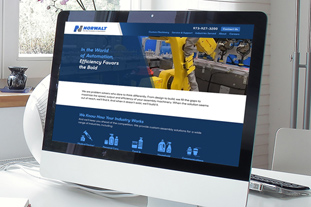In a recent article featured on Industry Today, our industrial marketing agency discussed how some manufacturers are starting to use their websites more effectively. Up until recently, the vast majority of manufacturing websites have been unsuccessful at converting enough leads. We shared some of the key criteria that define effective websites and spoke with a number of manufacturers to to hear how they’ve revamped their own sites.
Clearly Present Your Identity & Purpose
Just because you offer complex products and services, this doesn’t mean your website should be complex. If you hit visitors with too many specifics on the homepage, they’ll become overwhelmed and will likely leave your site. All that people want to know at this point is that you’re the type of company they’re looking for, i.e., you serve their industry and offer the products/services they need. This information should be placed above the fold so visitors have a clear understanding of who you are and what you do, as explained by this manufacturer. Treat your homepage as an overview of the site’s most important pages such as “About Us,” “Why Choose,” “Careers” and all of your main service/product pages. Then you can go into more specifics on the inner pages.
In addition to what you do, visitors want to know what your company values and stands for. Never underestimate the importance of company culture and what this means to your customers. Now more than ever, buyers want to work with manufacturers that treat their employees well, are environmentally conscious, have a clearly defined purpose and are doing their part to help promote a better world. While it’s important to convey the quality of your products and services, it’s equally important to convey the personality of your company.
Don’t Put Visitors to Work
As a manufacturing branding agency, one of the most common problems we encounter is extremely outdated websites. Many manufacturers haven’t touched their websites in years—and it shows. Outdated websites not only look bad, but they’re also not user-friendly. A web experience that was considered good 20 years ago is going to seem horrible to today’s users. Manufacturers must cater to the user experience through clear navigation menus, calls-to-action and an enhanced, mobile-friendly design. Even the outdated logo can present major challenges during a web overhaul, which is why we often encourage manufacturers to consider rebranding as the first necessary step.
Manufacturers (or any company for that matter) should never assume that visitors know what to do after reading content. Your website should have clear calls-to-action that tell readers exactly what you want them to do next. If a visitor has to work to try and find your contact information or you’re somehow leaving them in the dark, you’ll likely lose potential customers. The good news is that manufacturers don’t need to reinvent the wheel to understand some of the most basic and crucial web improvements. This manufacturer told us that when updating their own website, their marketing team thinks about their own personal pet peeves as a starting point. After all, if there’s something you yourself don’t like to experience as a web user, then why would you do it on your own website?
Stay One Step Ahead and Position Yourselves As Problem-Solvers
When a customer is deciding whether or not to contact you, they’re looking at their schedule and wondering if it’s worth their time. One of the most effective ways to get that call or email is by demonstrating a clear understanding of your customers’ problems. Customers want to know that you live in their world and know exactly what they need. By proactively addressing their problems, you’re putting the focus on them instead of you. Customers are much more likely to contact a company that’s focused on their needs rather than the company’s own product or service. It’s certainly important to discuss the benefits and features of your product, but put it within the context of solving your customers’ very real and specific problems.
If you offer a highly complex and specific product, you can also use your website as an informational tool. In the Industry Today article, one of the manufacturers told us that her company’s product is so rare that many customers don’t even know it’s an option. The responsibility falls on the company to explain what the product is, compare it to other products that customers already know about and then explain why it’s the best solution in certain applications. The company is proactively using its website as an informational tool to present a solution that visitors otherwise wouldn’t know existed.
Treat Your Website As a Marathon, Not a Race
All of the manufacturers we spoke with agreed on the importance of continually monitoring and improving their websites. Google Analytics, recurring web meetings and regular content updates (with or without the help of industrial copywriters) are just some of the ways manufacturers are staying on top of their websites.
Though the industry has a long way to go, it’s clear that manufacturers are on the upswing with their websites. More and more companies are leveraging digital marketing and letting their websites do the heavy lifting to convince customers and convert leads.



